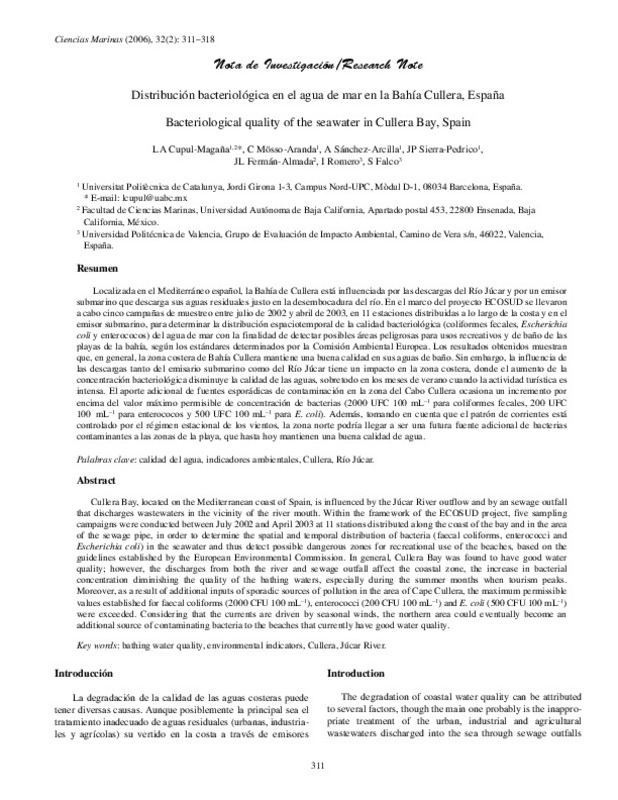JavaScript is disabled for your browser. Some features of this site may not work without it.
Buscar en RiuNet
Listar
Mi cuenta
Estadísticas
Ayuda RiuNet
Admin. UPV
Distribución bacteriológica en el agua de mar en la Bahía Cullera, España
Mostrar el registro sencillo del ítem
Ficheros en el ítem
| dc.contributor.author | Cupul-Magaña, LA
|
es_ES |
| dc.contributor.author | Mösso Aranda, César
|
es_ES |
| dc.contributor.author | Sánchez-Arcilla, A.
|
es_ES |
| dc.contributor.author | Sierra-Pedrico, J.P,
|
es_ES |
| dc.contributor.author | Fermán-Almada, JL
|
es_ES |
| dc.contributor.author | Romero Gil, Inmaculada
|
es_ES |
| dc.contributor.author | Falco Giaccaglia, Silvia Laura
|
es_ES |
| dc.date.accessioned | 2014-03-04T09:22:39Z | |
| dc.date.available | 2014-03-04T09:22:39Z | |
| dc.date.issued | 2006 | |
| dc.identifier.issn | 0185-3880 | |
| dc.identifier.uri | http://hdl.handle.net/10251/36116 | |
| dc.description.abstract | Localizada en el Mediterráneo español, la Bahía de Cullera está influenciada por las descargas del Río Júcar y por un emisor submarino que descarga sus aguas residuales justo en la desembocadura del río. En el marco del proyecto ECOSUD se llevaron a cabo cinco campañas de muestreo entre julio de 2002 y abril de 2003, en 11 estaciones distribuidas a lo largo de la costa y en el emisor submarino, para determinar la distribución espaciotemporal de la calidad bacteriológica (coliformes fecales, Escherichia coli y enterococos) del agua de mar con la finalidad de detectar posibles áreas peligrosas para usos recreativos y de baño de las playas de la bahía, según los estándares determinados por la Comisión Ambiental Europea. Los resultados obtenidos muestran que, en general, la zona costera de Bahía Cullera mantiene una buena calidad en sus aguas de baño. Sin embargo, la influencia de las descargas tanto del emisario submarino como del Río Júcar tiene un impacto en la zona costera, donde el aumento de la concentración bacteriológica disminuye la calidad de las aguas, sobretodo en los meses de verano cuando la actividad turística es intensa. El aporte adicional de fuentes esporádicas de contaminación en la zona del Cabo Cullera ocasiona un incremento por encima del valor máximo permisible de concentración de bacterias (2000 UFC 100 mL¿1 para coliformes fecales, 200 UFC 100 mL¿1 para enterococos y 500 UFC 100 mL¿1 para E. coli). Además, tomando en cuenta que el patrón de corrientes está controlado por el régimen estacional de los vientos, la zona norte podría llegar a ser una futura fuente adicional de bacterias contaminantes a las zonas de la playa, que hasta hoy mantienen una buena calidad de agua. | es_ES |
| dc.description.abstract | Cullera Bay, located on the Mediterranean coast of Spain, is influenced by the Júcar River outflow and by an sewage outfall that discharges wastewaters in the vicinity of the river mouth. Within the framework of the ECOSUD project, five sampling campaigns were conducted between July 2002 and April 2003 at 11 stations distributed along the coast of the bay and in the area of the sewage pipe, in order to determine the spatial and temporal distribution of bacteria (faecal coliforms, enterococci and Escherichia coli) in the seawater and thus detect possible dangerous zones for recreational use of the beaches, based on the guidelines established by the European Environmental Commission. In general, Cullera Bay was found to have good water quality; however, the discharges from both the river and sewage outfall affect the coastal zone, the increase in bacterial concentration diminishing the quality of the bathing waters, especially during the summer months when tourism peaks. Moreover, as a result of additional inputs of sporadic sources of pollution in the area of Cape Cullera, the maximum permissible values established for faecal coliforms (2000 CFU 100 mL¿1), enterococci (200 CFU 100 mL¿1) and E. coli (500 CFU 100 mL¿1) were exceeded. Considering that the currents are driven by seasonal winds, the northern area could eventually become an additional source of contaminating bacteria to the beaches that currently have good water quality | es_ES |
| dc.format.extent | 8 | es_ES |
| dc.language | Español | es_ES |
| dc.publisher | Universidad Autónoma de Baja California | es_ES |
| dc.relation.ispartof | Ciencias Marinas | es_ES |
| dc.rights | Reserva de todos los derechos | es_ES |
| dc.subject | Calidad del agua | es_ES |
| dc.subject | Indicadores ambientales | es_ES |
| dc.subject | Cullera | es_ES |
| dc.subject | Río Júcar | es_ES |
| dc.subject | Bathing water quality | es_ES |
| dc.subject | Environmental indicators | es_ES |
| dc.subject | Júcar River | es_ES |
| dc.subject.classification | TECNOLOGIA DEL MEDIO AMBIENTE | es_ES |
| dc.title | Distribución bacteriológica en el agua de mar en la Bahía Cullera, España | es_ES |
| dc.title.alternative | Bacteriological quality of the seawater in Cullera Bay, Spain | es_ES |
| dc.type | Artículo | es_ES |
| dc.identifier.doi | 10.7773/cm.v32i21.1058 | es_ES |
| dc.rights.accessRights | Abierto | es_ES |
| dc.contributor.affiliation | Universitat Politècnica de València. Departamento de Ingeniería Hidráulica y Medio Ambiente - Departament d'Enginyeria Hidràulica i Medi Ambient | es_ES |
| dc.contributor.affiliation | Universitat Politècnica de València. Instituto de Investigación para la Gestión Integral de Zonas Costeras - Institut d'Investigació per a la Gestió Integral de Zones Costaneres | es_ES |
| dc.description.bibliographicCitation | Cupul-Magaña, L.; Mösso Aranda, C.; Sánchez-Arcilla, A.; Sierra-Pedrico, J.; Fermán-Almada, J.; Romero Gil, I.; Falco Giaccaglia, SL. (2006). Distribución bacteriológica en el agua de mar en la Bahía Cullera, España. Ciencias Marinas. 32(2):311-318. doi:10.7773/cm.v32i21.1058 | es_ES |
| dc.description.accrualMethod | S | es_ES |
| dc.relation.publisherversion | http://dx.doi.org/10.7773/cm.v32i21.1058 | es_ES |
| dc.description.upvformatpinicio | 311 | es_ES |
| dc.description.upvformatpfin | 318 | es_ES |
| dc.type.version | info:eu-repo/semantics/publishedVersion | es_ES |
| dc.description.volume | 32 | es_ES |
| dc.description.issue | 2 | es_ES |
| dc.relation.senia | 29929 |








